Thailand has long been a tourism hotspot, and is also seeing growing numbers of Thai residents travelling abroad. But how is this shaping cross-border card usage? We explore both inbound and outbound data to find out.
Southeast Asia is one of a number of emerging markets regions that many payments players are seeing as critical to future growth and within this, Thailand is one of the region’s most important economies.
It is also a key focus for both inbound and outbound cross-border payments, in part aided by travel. It has a long-standing reputation as a global tourism hot-spot, but is also seeing growing numbers of Thai citizens travelling abroad, with just below half planning to take an international trip in 2024.
While e-wallets have become a popular payment type for residents in the country, card ownership is also high, with both credit and debit cards seeing sharp growth in recent years, creating key opportunities for the card industry. Meanwhile the country supports a broad range of payment types, with card use remaining popular for many foreign travellers.
However, Thailand has also faced significant economic headwinds that have created challenges to both inbound and outbound travel, not least the Covid-19 pandemic, in turn leading to headwinds for cross-border payments companies catering to the region.
With this in mind, we dig into data published by the Bank of Thailand for cross-border card payments both into and out of Thailand, to get a sense of how the country’s international use of payment instruments has evolved and to what extent they have been shaped by its changing conditions.
Thailand’s card payment landscape
For those living in Thailand, card use has risen over the past few years. Debit card ownership, which stood at 55% of the Thai population aged over 15 in 2014, climbed to 63% in 2021, according to the World Bank’s Global Financial Inclusion database. This puts it notably above the global average of 53% in 2021.
By contrast, while credit card ownership is lower, it has seen a more significant rise, growing from 6% in 2014 to 23% in 2021. This remains slightly below the 25% global average for credit card ownership in 2021 .
What has changed the most in Thailand’s payments landscape over this period, however, is the frequency of mobile money accounts, often also referred to as digital wallets. While just 1% of the adult population in Thailand had such an account in 2014, this stood at 60% in 2021 and if its rate of growth has continued, it may now have a higher share than debit cards today. By contrast, the 2021 global average for a mobile money account is just 10%.
The Thailand central bank dataset explored in this report does not include payments made with mobile money accounts, however their growing use underscores the importance of providing broad payment capabilities when catering to this market.
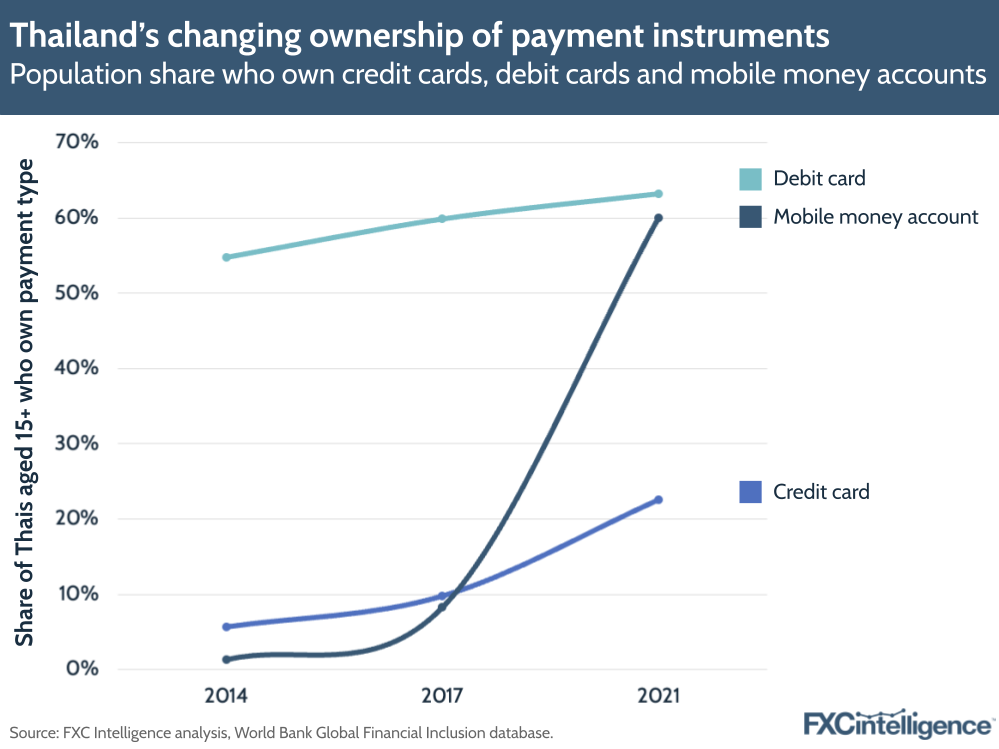
Visitors to Thailand also have high debit card use. Among the top 10 countries of origin for visitors as determined by government tourism service Sawasdee Thailand, debit card ownership averaged 67% in 2021 (it should be noted that Vietnam’s data was collected in 2022 not ‘21), with five of the 10 (Hong Kong, South Korea, Malaysia, the UK and the US) having ownership of above 80%.
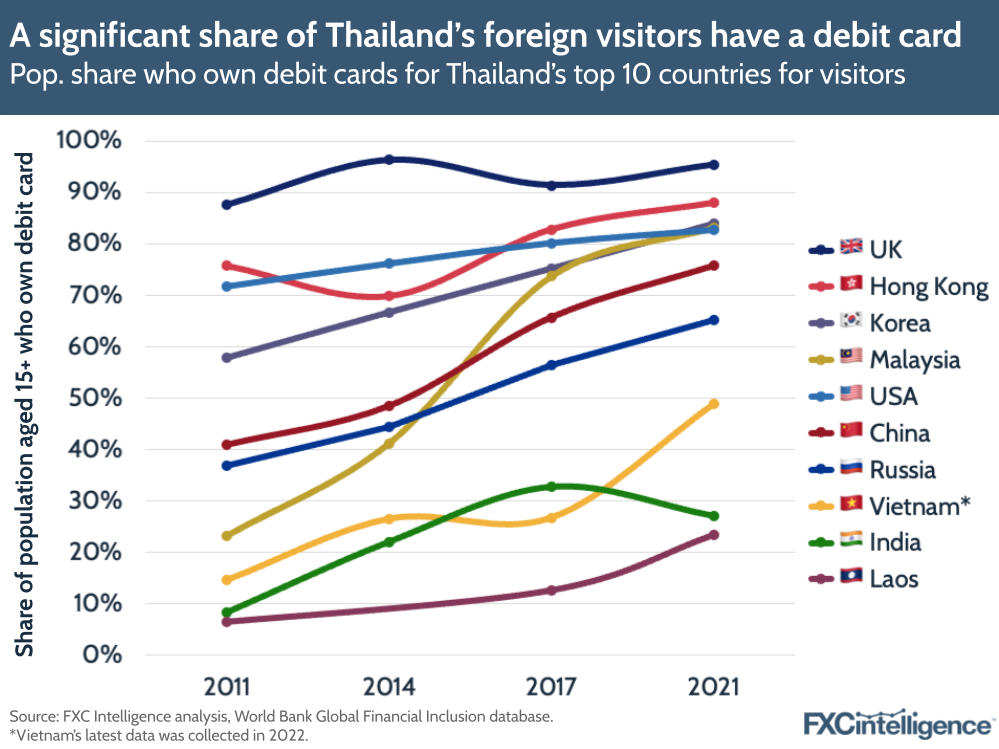
Credit card ownership among visitors is lower by contrast, at a 35% average for all 10 countries. However, it is significantly above global averages, with Hong Kong, South Korea, the UK and the US all having 60%+ ownership.
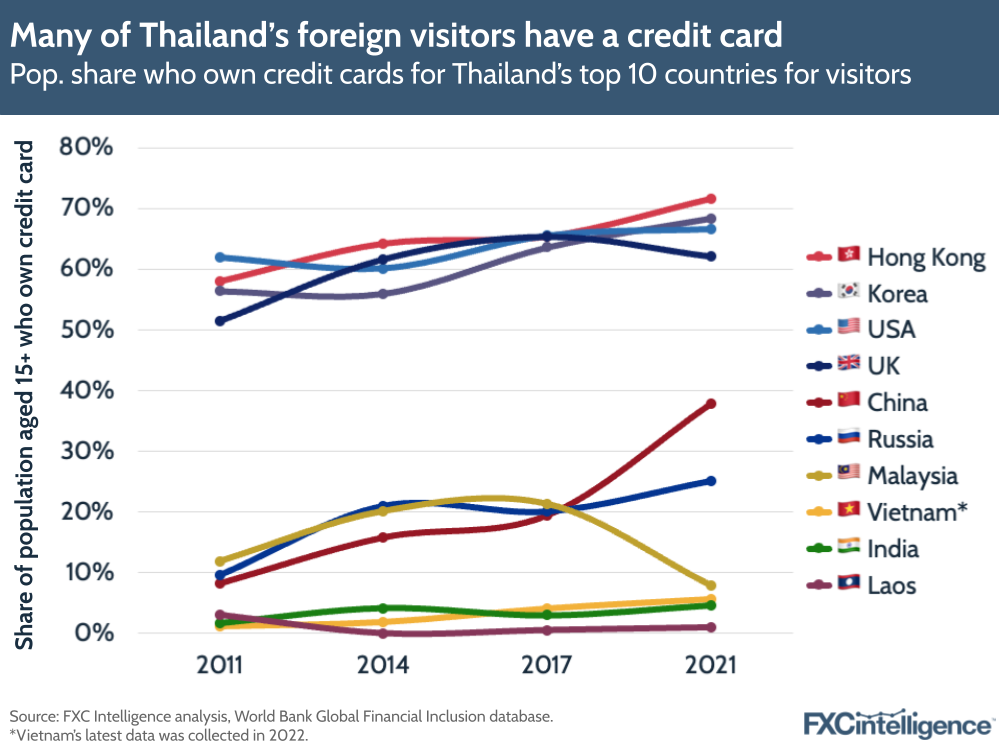
The World Bank’s data on mobile money account ownership is considerably less complete, with no data available for five of the 10 countries, including China and Hong Kong, where ownership is likely to be high, and the UK and US, where ownership is much lower. However, of the five where data is available, ownership of mobile money accounts averaged at around 19% in 2021.
As a result, inbound cross-border card payments made via both debit and credit cards are likely to account for the majority of non-cash payments made by visitors to Thailand.
Outbound cross-border card trends: International usage of cards issued in Thailand
For payments made abroad using cards issued in Thailand, there has been steady growth in the number of transactions. These saw an overall increase of 6% YoY in H1 2024 to 69.3 million, versus H1 2023’s 65.4 million. They also grew 27% in the four years between H1 2020 (54.6 million), when Thailand was still being impacted by the pandemic, and H1 2024.
Flows, and therefore the amounts people are spending abroad using cards issued in Thailand, have increased more significantly however. In H1 2024 these stood at THB 156.7bn ($4.4bn), a 5% YoY increase on H1 23’s THB 149.8bn ($4.3bn). However, flows saw four-year growth of 99% between H1 2020’s THB 78.7bn ($2.5bn) and H1 2024.
While both have seen growth, within this there has also been a notable shift in the share of different payment types and channels, with increases across credit card use while ATM use has declined.
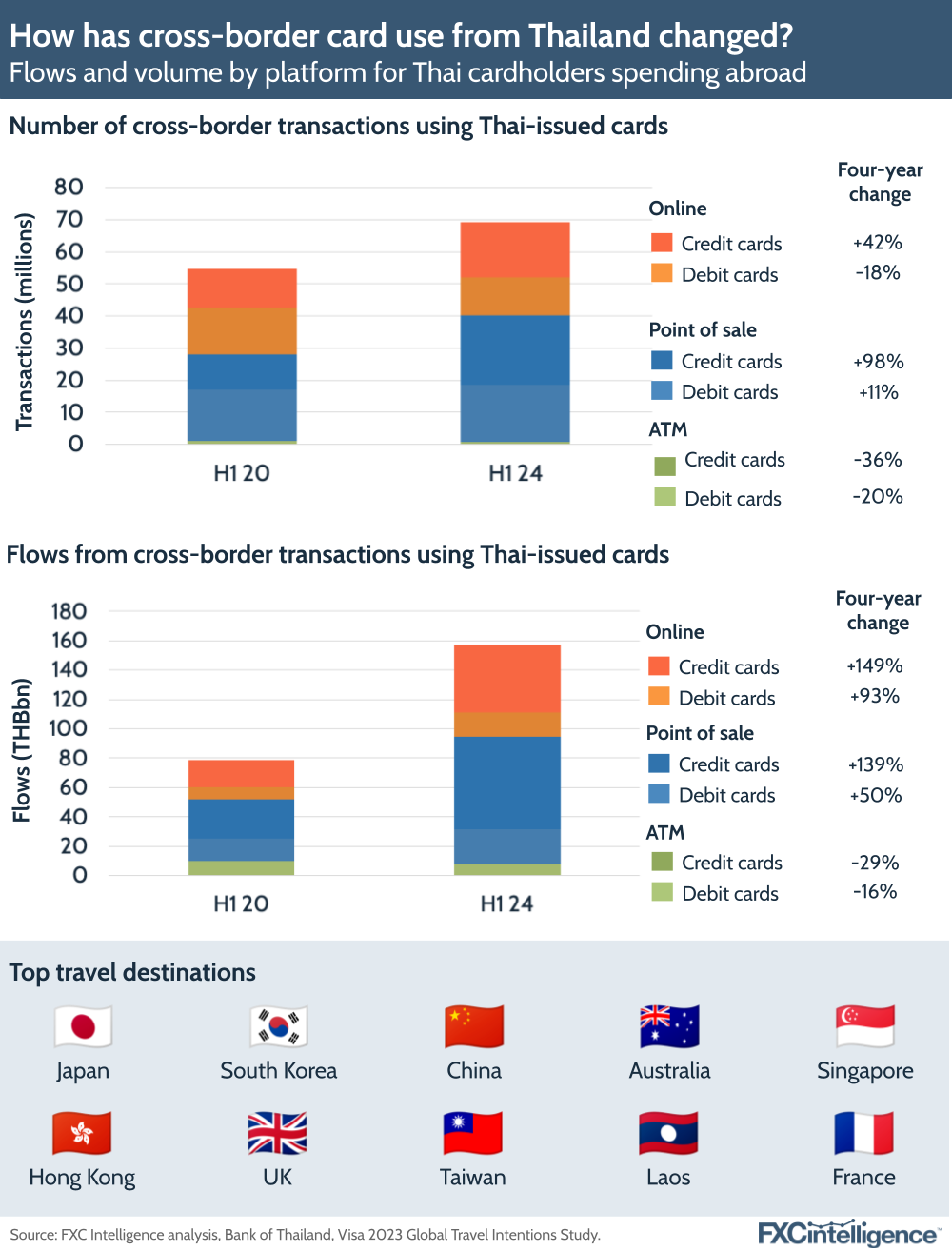
Growing outbound cross-border card flows
While Thailand saw a notable decline in flows during the pandemic, it saw strong, consistent growth between 2020 and 2023, although overall spend volumes appear to have levelled out over the past 12 months, with much more modest overall growth during this period.
This indicates a relatively speedy return to pre-pandemic norms in terms of cross-border card spending using those issued in Thailand, with 2022 levels already passing those of 2019.
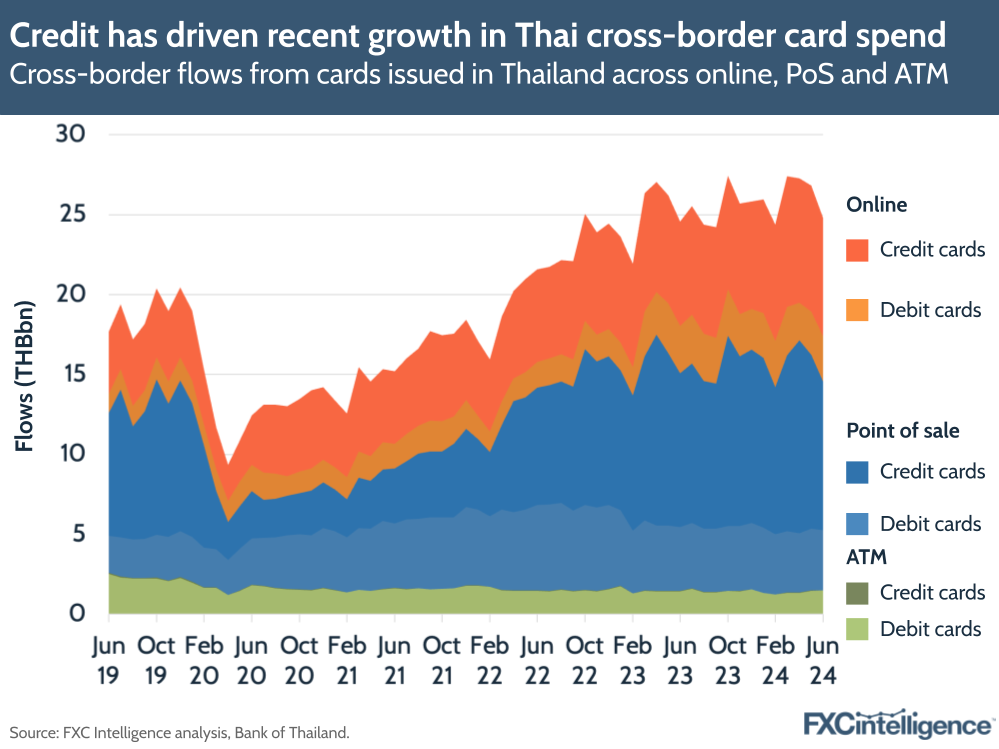
While drops in credit card spending drove a disproportionate amount of the pandemic-era contraction, use of credit cards has seen the biggest growth over the past few years, with an average growth rate of more than 40% YoY for most quarters between Q2 2021 and Q1 2023.
By contrast, debit card growth remained positive during this period, but never passed around 30% and has been steadily slowing since Q2 2021.
However, growth from Q2 2023 onwards has been much more muted for both card types, dropping into negative growth for debit and reducing below 20% from Q3 2023 onwards for credit. This is likely being driven by a contraction in the Thai economy, which saw just 1.9% growth in 2023 and is projected by the World Bank to grow by 2.4% in 2024, attributed to a combination of challenging macroeconomic conditions and a tough domestic political landscape.
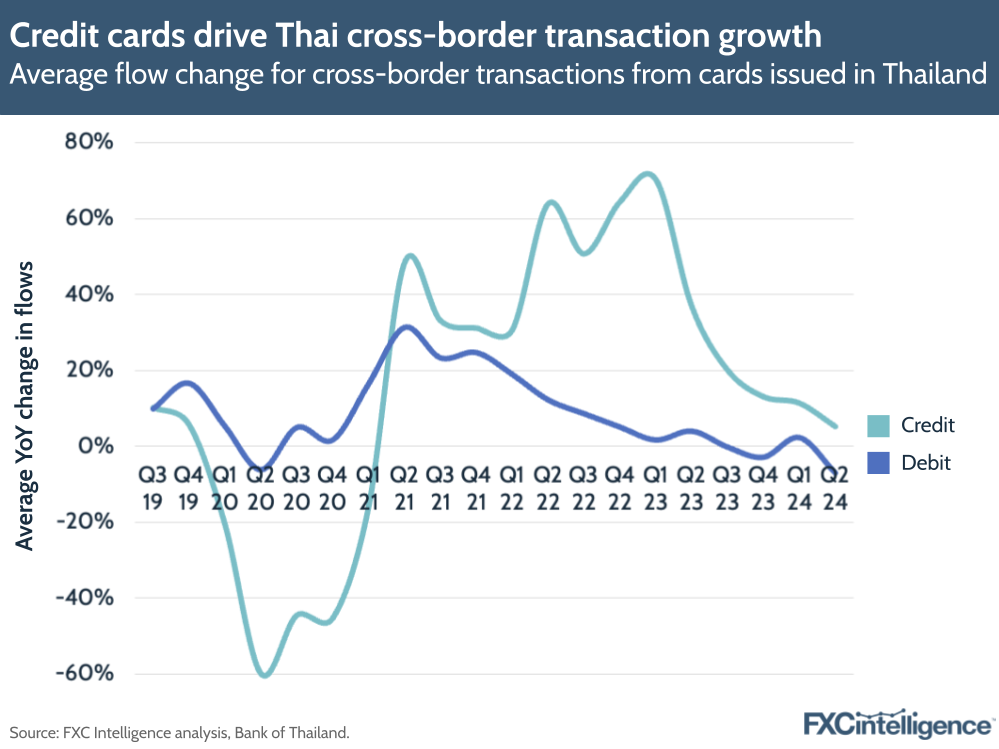
Looking to payment channels, the most interesting thing to note is how much of an inverse relationship there is between growth rates of ATM use and those for online and point-of-sale for both credit and debit cards.
During the pandemic, growth rates for cross-border flows from ATMs climbed to a high of 29% in Q4 2020. This is interesting as it goes against trends of a shift away from cash use during the pandemic, driven by fears associated with disease transmission, as well as reported trends within Thailand, where 57% of people said they were using cash less often. However, this may reflect a trend more in cross-border use, and in particular the types of people who were still making cross-border ATM withdrawals during this period.
Since mid-2021, however, both online and point-of-sale both saw consistent strong growth through to 2023, while ATM use declined, although all have seen drops into negative growth over the past 12 months.
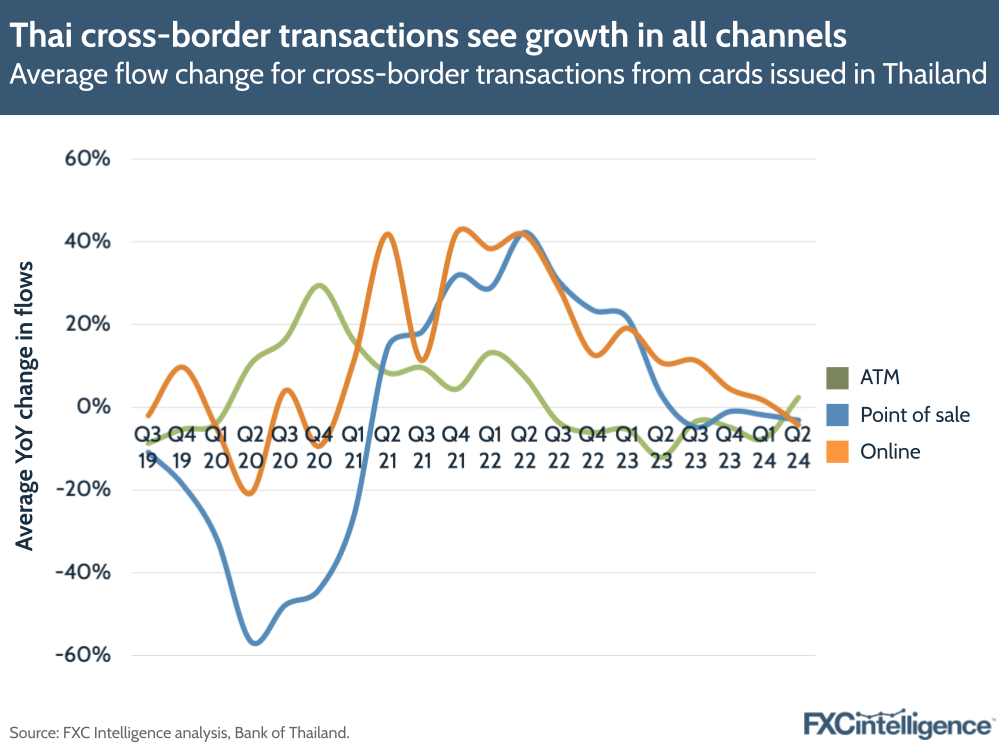
Increasing transactions and spend per transaction
As of June 2024, the most recently available data point, the number of cross-border card transactions using cards issued in Thailand stood at 11.5 million, a 5% increase on June 2023 and a 20% increase on June 2020.
Interestingly, the number of transactions did not see the same sharp drop during the pandemic that flows did and the patterns of growth were different. ATM saw YoY declines in transaction numbers across 2020 and 2021 – echoing trends around cash decline during the pandemic – but returned to growth across 2023 before declining again in 2024.
Point-of-sale, meanwhile, saw consistent double-digit growth from 2021 to mid-2023, when this dropped initially to low single-digit growth and then into negative growth in 2024. By contrast, online saw a period of decline in 2022 when it was lapping 2021, a year when the pandemic drove very elevated online spending globally, however has seen consistent growth in cross-border transaction numbers since.
Credit cards, meanwhile, saw declining transaction numbers in 2020 and 2021, but has seen YoY growth every month since, while debit card spending was growing across 2023 but has shrunk in 2024.
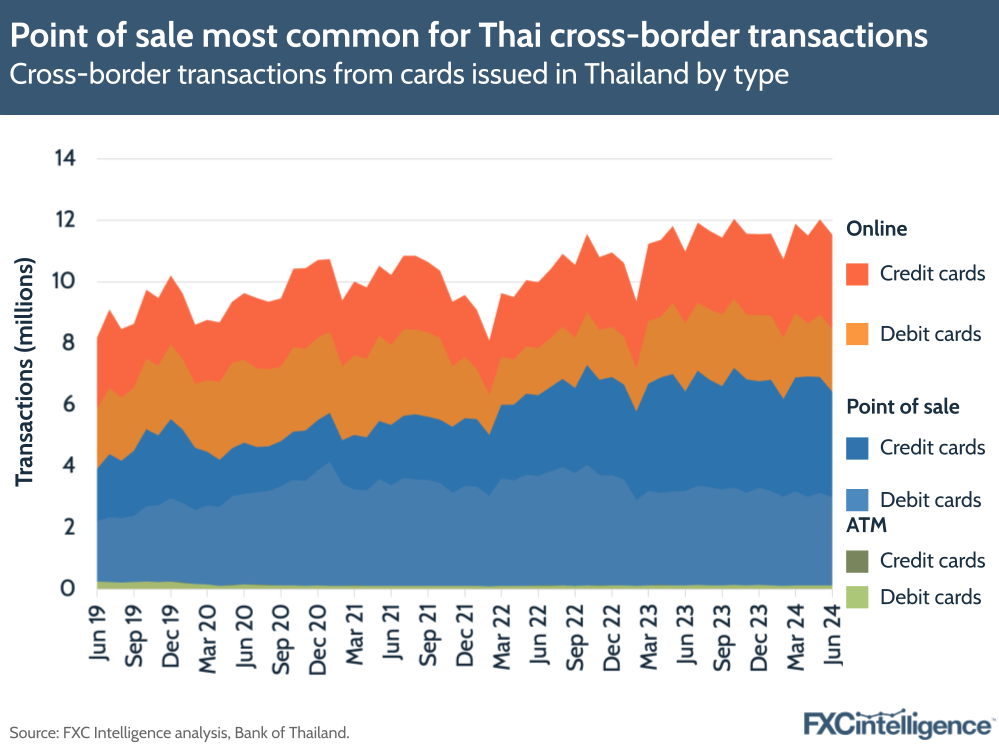
This combination of factors has an average spend per transaction that has evolved over time, with both debit and credit card ATM transactions consistently seeing the highest average spend per transaction at around THB 11,000 ($300) in June 2024 for debit and TBH 10,500 ($286) for credit.
Notably, the average spend per ATM debit transaction has decreased while the number of ATM credit transactions has been more seasonally erratic but has remained broadly the same, indicating that the drop-off is primarily in lower-value cross-border ATM withdrawals.
Meanwhile, average spend value for online transactions has remained fairly consistent across both debit (c. THB 1,400 or $40 in June 2024) and credit (c. THB 2,400 or $66), although both have been trending slightly upwards over the past few years. However, while point of sale debit transactions have also remained fairly flat at c. THB 1,300 ($36), credit remains higher at c. THB 2,700 ($74).
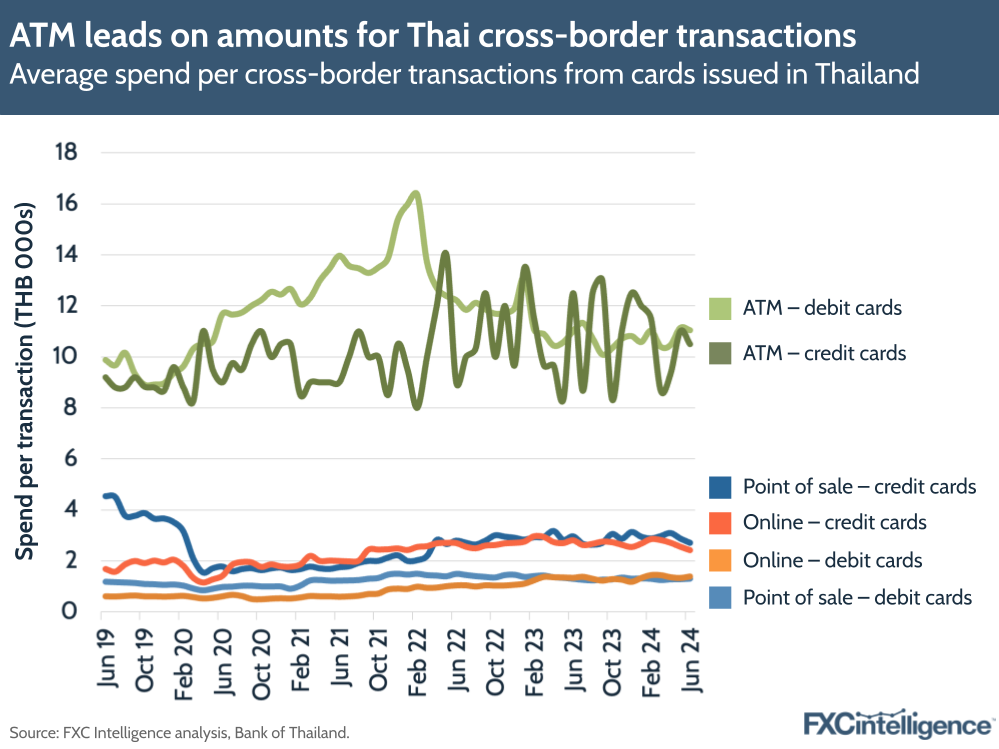
While ATM spending per transaction is high, this segment remains the smallest share in terms of both flows and numbers of transactions. Point-of-sale accounted for 53% of cross-border card flows and 55% of transactions from Thailand in June 2024, while online accounted for 41% of flows and 44% of transactions.
Notably, while online has remained relatively consistent in terms of share throughout the pandemic and beyond, PoS has seen its share of transactions increase at the expense of ATMs. It appears that travellers from Thailand are not only spending more abroad using their cards, but are also increasingly using them to pay for goods and services directly.
Inbound cross-border card trends: Usage of foreign cards in Thailand
Turning to cross-border card transactions in Thailand using cards issued elsewhere, there has been much more dramatic growth between 2020 and 2024. Foreign card transactions in the country totalled around 133 million in H1 2024, a 38% YoY increase from H1 2023’s 96 million. However, they rose 178% in the four years between H1 2020, when they totalled 48 million, and H1 2024.
Flow increases are similar, with foreign card spend totalling around THB 393bn ($10.9bn) in H1 2024, a 21% increase on H1 2023’s THB 323bn ($9.3bn) and 163% up on H1 2020’s THB 149bn ($4.8bn).
The pandemic and the re-opening of travel to Thailand has been a sharp driver of growth over the past few years. Thailand enacted country-wide lockdown measures at the height of Covid-19, including the requirement of a seven-day quarantine period for visitors during 2021. As with many regions, this hit tourism in the country severely and, while travel from South Asia and Southeast Asia is now well above 2019 levels, as of 2024 visitor arrivals are reported to still be slightly below those of 2019.

Changes to inbound cross-border card flows
The impact of the pandemic is very clear in the changing flows from foreign-issued cards into Thailand over the past few years. While in 2019 total flows for cross-border card spend in Thailand stood at around THB 506bn ($16bn), this shrank to THB 229bn ($7bn) in 2020 and THB 176bn ($5.5bn) in 2021. However, spending passed 2019 numbers for the first time in 2023, when they totalled THB 651bn ($187bn).
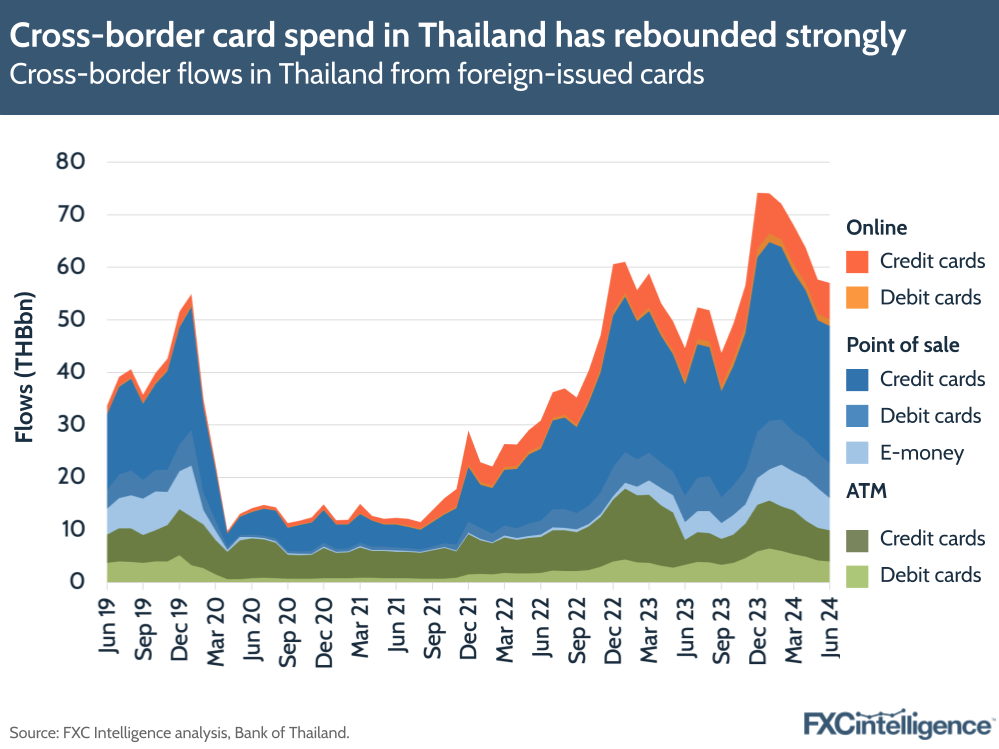
Within this, while there has been growth in both debit and credit card spending, debit cards account for the majority of flows, particularly on the point-of-sale side, and also saw the most marked YoY growth.
In lapping very muted pandemic numbers, there was an inevitable leap in growth rates during 2022, to a high of around 300% YoY for debit card flows in Q3 2022. However, growth rates remain very elevated, with c. 50% YoY growth rates for debit cards Q2 2024 being the lowest growth rate since the start of the pandemic.
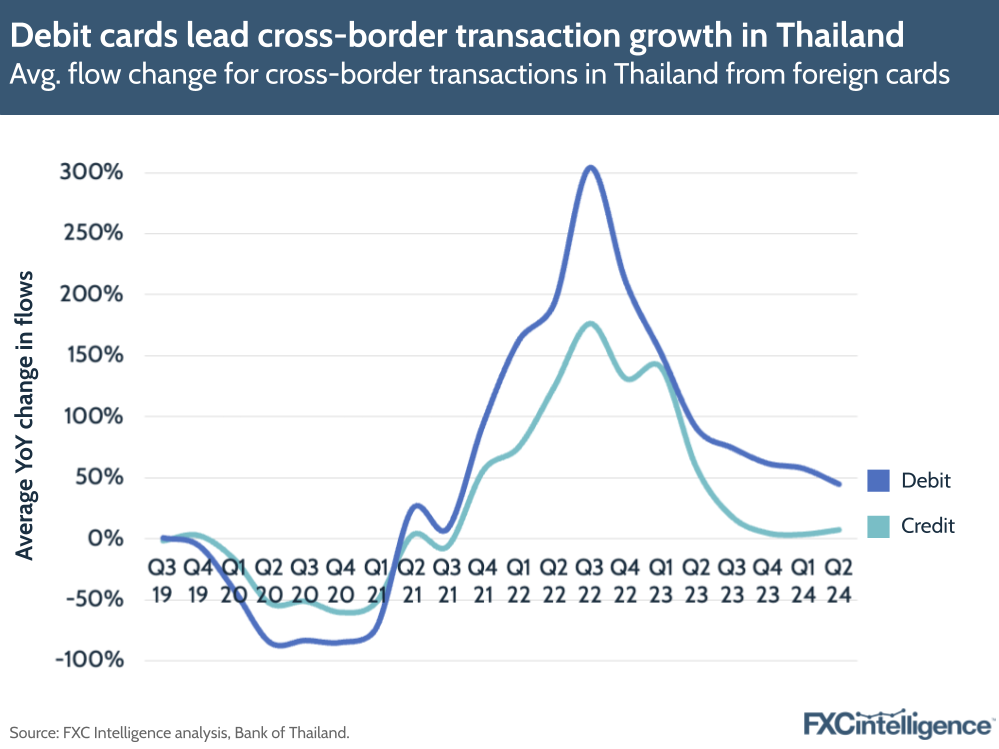
Looking to channels, the global rise in online spending during the pandemic drove a surge in online cross-border card transactions in Thailand in 2021 and 2022, which saw YoY growth rates climb to highs of over 60%. However, YoY growth rates for online flows since then have been in consistent decline.
By contrast, there has been consistent growth in flows for both ATM and point-of-sale flows since the pandemic – likely a reflection of the resurgence of foreign travellers that the country has seen.
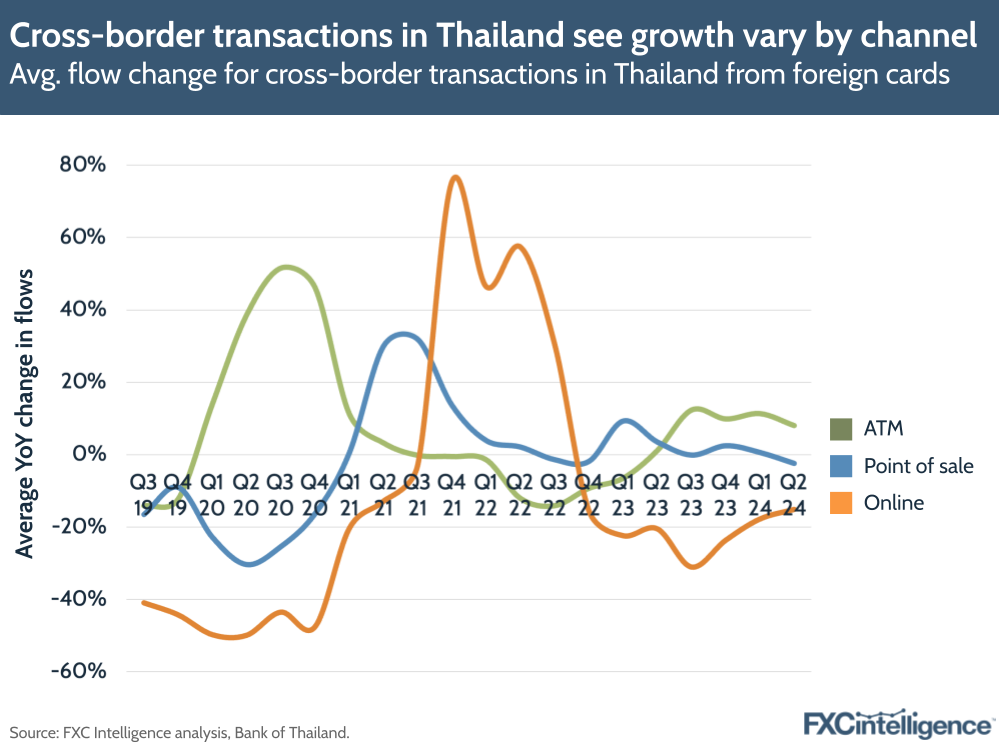
Growth in transactions and spend per transaction
Looking at transactions, June 2024 saw the total from cross-border cards in Thailand reach 20.6 million, a 45% increase on June 2023 and a 284% increase on June 2020.
While online has seen a recent drop in flows, the number of transactions has climbed significantly, with growth rates not dropping below 60% since mid-2021 until June 2024’s 53% and seeing three-digit YoY growth in many months.
Point-of-sale, which for inbound also includes e-money – prepaid cards loaded with the local currency – has meanwhile also seen consistent growth in transaction numbers, which were in low three figures across 2022 into mid-2023, and have since sat at around 50-60%.
However, while ATM transaction figures also saw 100%+ growth across 2022 and into early 2023, this has since dropped to less than 10% YoY growth, with some 2024 months seeing a slight contraction. This may reflect a broader move away from cash use, particularly in regions that have begun to return to travelling in Thailand more recently.
Growth in the number of transactions using debit cards has consistently been at over 100% YoY since 2022, although dropped to 46% YoY growth for the first time since the start of the pandemic in June 2024. However, preference for credit card use has been considerably more muted. While in 2022 it sat at around 60-90% growth YoY, this reduced to below 20% mid-2023 and then down around 2% in Q4 2023, before dropping to negative in early 2024. However, June 2024 has seen a resurgence of 26% YoY growth, raising the question of whether this will be a longer-term trend.
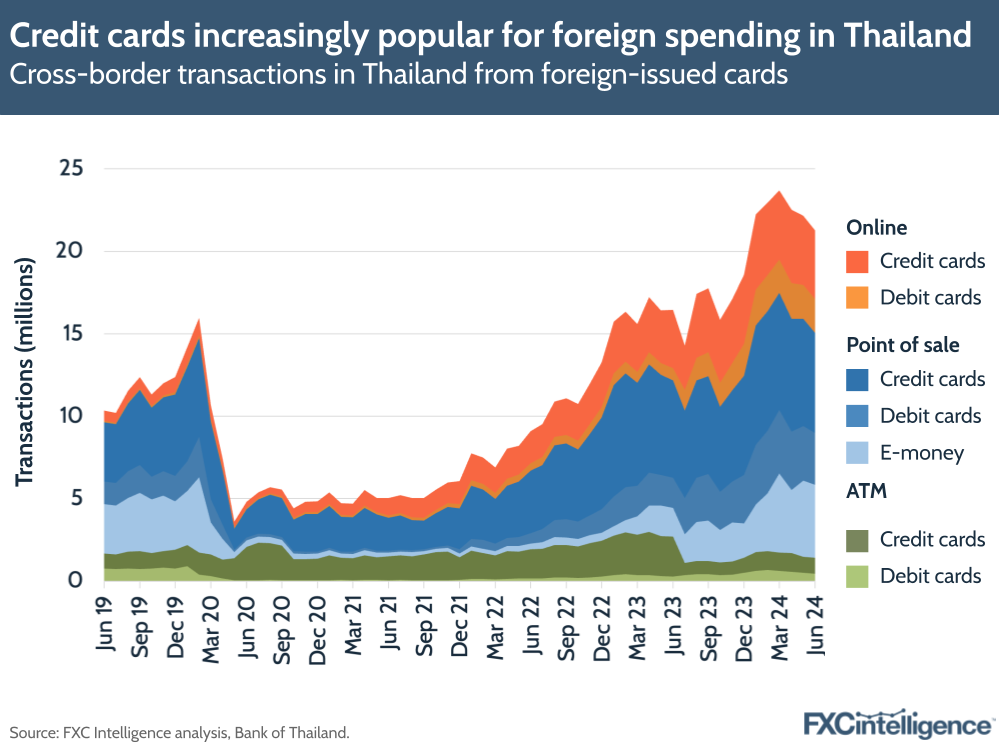
On average spend per transaction ATM use is again the highest, with debit averaging around THB 9,330 ($254) in June 2024, while credit averaged THB 6,250 ($170), although average amounts withdrawn on debit have been slowly declining, while credit has risen.
By contrast, credit at point-of-sale had a higher average transaction value than debit, at THB 4,260 ($116) versus debit’s THB 2,070 ($56), although debit spend has again been reducing while credit has climbed. E-money had the lowest average for point-of-sale, at THB 1,480 ($40).
As with outbound cross-border transactions, online had the lowest average spend per transaction, at THB 1,900 ($52) for credit and THB 610 ($17) for debit, although debit has risen from 2022 levels.
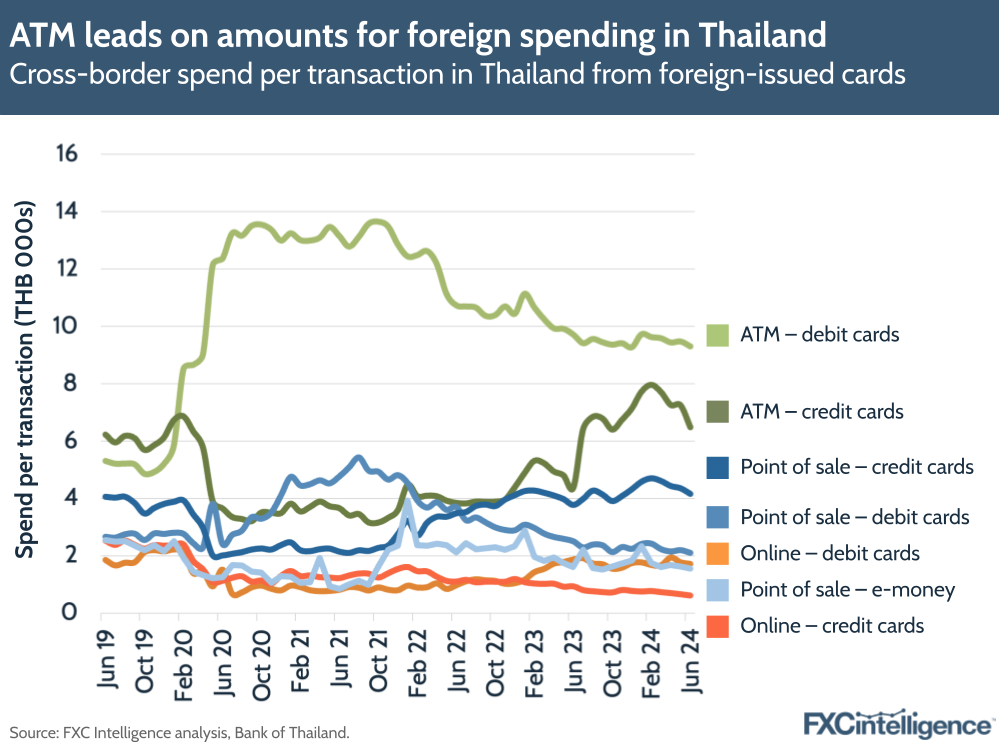
More money is coming into Thailand from abroad via cards than has been the case in the past, with much of it now being spent through point-of-sale terminals. As of June 2024, PoS accounts for 65% of Thailand’s inbound cross-border transactions and 68% of inbound cross-border flows.
However, with spending on the debit side per transaction having dropped notably since 2021, the drive is not so much in people spending more, but more people spending the same amounts or less, as Thailand once again becomes a favoured holiday destination for people in many parts of the world.



